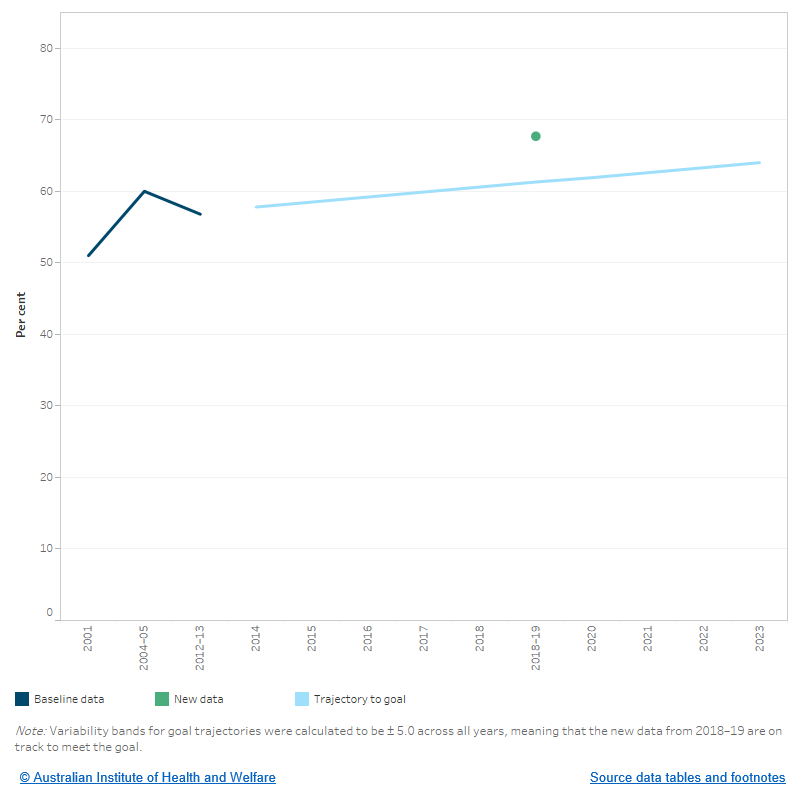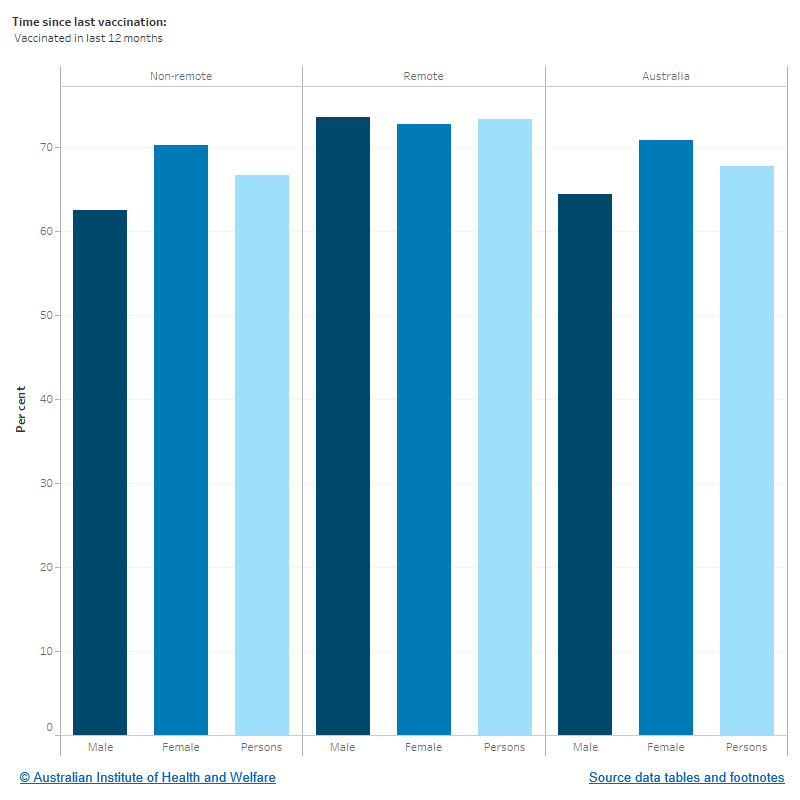Goal 19: Immunisation for influenza – people aged 50 and over
This indicator reports on the proportion of Aboriginal and Torres Strait Islander people aged 50 and over who are immunised for influenza. The goal for this indicator is 64% by 2023.
Why is it important?
Immunisation is important in protecting older Aboriginal and Torres Strait Islander people against harmful infectious diseases. Indigenous Australians may be at increased risk of severe illness resulting from influenza due to other risk factors and comorbidities.
What data are available?
Data on immunisation for influenza are available from ABS health survey data. The most recent such survey with estimates for Indigenous people was the 2018–19 National Aboriginal and Torres Strait Islander Health Survey (ABS 2019).
What do the data show?
There is no new data available since the last update, however the most recent assessment showed that progress towards the goal was on track.
- The proportion of Indigenous Australians aged 50 and over who reported that they had been vaccinated against influenza in the previous 12 months in 2018–19 was 68%, which was above the trajectory point of 61% required to meet the goal.
- The rate increased over time from 51% in 2001 to 68% in 2018–19.
- In 2018–19, the rate (68%) was above the trajectory point required to meet the goal (61%). Furthermore, the rate was above the goal for 2023 (64%).
In 2018–19, among Aboriginal and Torres Strait Islander people aged 50 and over:
- 62% of those aged 50–64, and 84% of those aged 65 and over reported that they had been vaccinated against influenza in the previous 12 months
- 20% of those aged 50–64, and 8.5% of those aged 65 and over had never been vaccinated against influenza.
- Indigenous Australians aged 50 and over who lived in Remote areas were more likely to be vaccinated against influenza than those in Non-remote areas—73% compared with 67%.
Figure 19.1: Aboriginal and Torres Strait Islander people aged 50 and over who were immunised for influenza in the previous 12 months
This figure shows the baseline data, from 2001 to 2012–13, the trajectory towards the goal, from 2014 to 2023. New data from 2018–19 for the proportion of Indigenous Australians aged 50 and over who were immunised for influenza in the previous 12 months are also plotted. There is only one data point—in 2018–19, 67.7% of Indigenous Australians aged 50 and over were immunised for influenza in the previous 12 months. This means that the 2023 goal (64%) has already been achieved.

Figure 19.2: Aboriginal and Torres Strait Islander people aged 50 and over who reported being immunised for influenza, by sex, remoteness and timing of vaccination, 2018–19
The figure shows the rate of influenza immunisation (in the last 12 months) among Indigenous Australians aged 50 and over, by remoteness and sex. The rate was slightly higher in remote areas (73.4%) than in non-remote areas (66.7%). Across Australia, females were more likely to get vaccinated than males (70.9% and 64.4%, respectively).

Figure 19.3: Aboriginal and Torres Strait Islander people aged 50 and over who reported being immunised for influenza, by age group and timing of vaccination, 2018–19
The figure shows that Indigenous Australians aged 65+ were more likely to be vaccinated for influenza in the last 12 months than those aged 50–64 (83.5% compared to 61.5%). Indigenous Australians aged 50–64 years were more likely to have been never vaccinated for influenza than those aged 65+ (20.1% compared to 8.5%).

References
ABS (Australian Bureau of Statistics) 2019. National Aboriginal and Torres Strait Islander Health Survey. Canberra: ABS. Viewed 28 October 2020.


